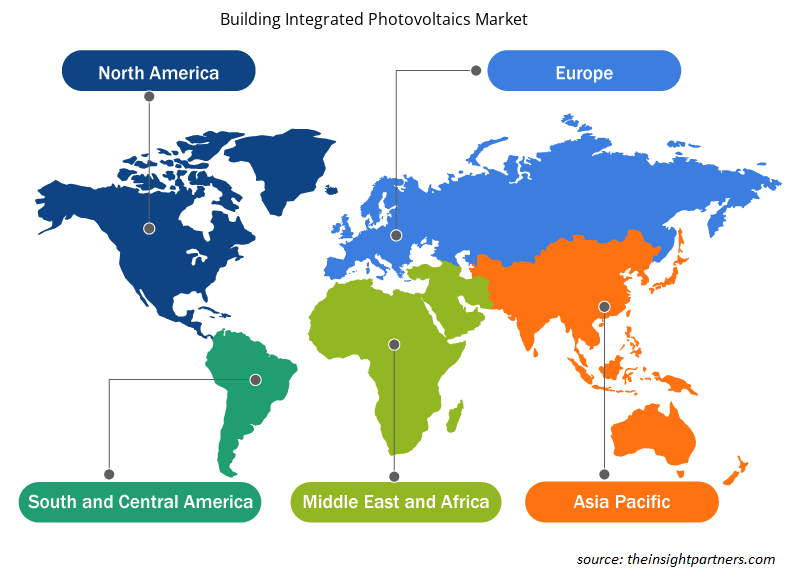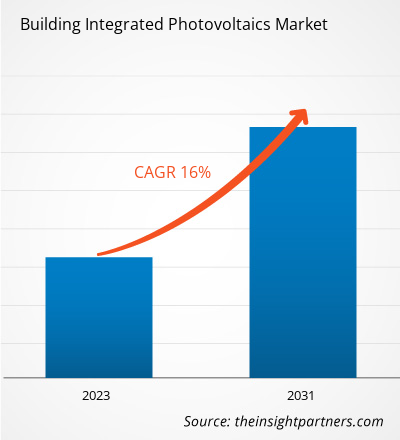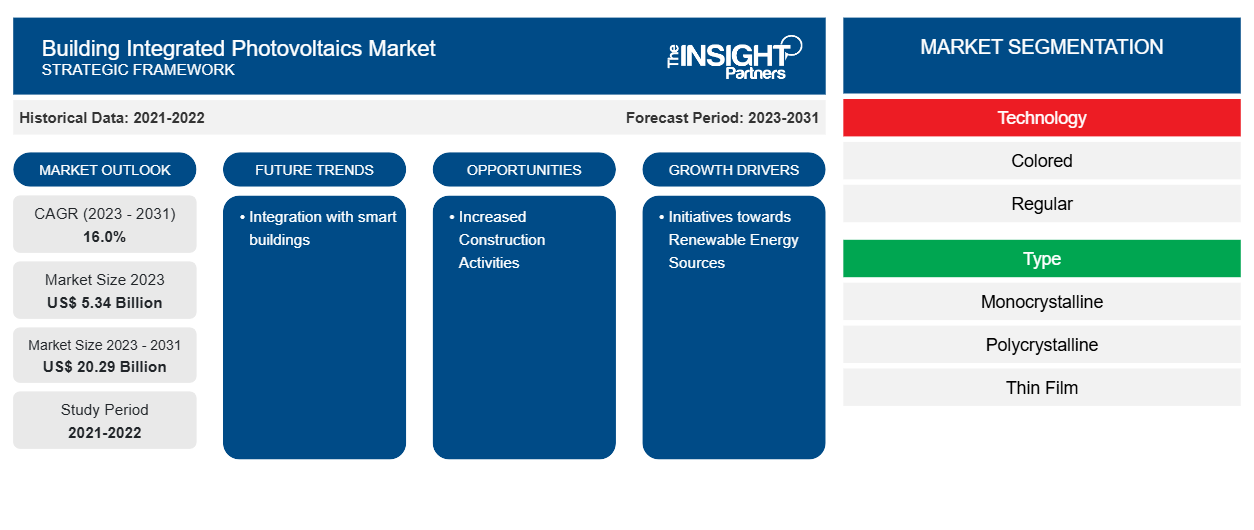Le marché du photovoltaïque intégré aux bâtiments devrait atteindre 20,29 milliards USD d'ici 2031, contre 5,34 milliards USD en 2023. Le marché devrait enregistrer un TCAC de 16,0 % au cours de la période 2023-2031. L'intégration avec les bâtiments intelligents devrait rester une tendance clé du marché.
Analyse du marché du photovoltaïque intégré aux bâtiments
La demande croissante en énergie renouvelable, combinée à l’électrification des transports et à l’implication accrue des sociétés pétrolières et gazières dans la chaîne de valeur de l’électricité, accélère la convergence des industries d’utilisation finale.
Aperçu du marché du photovoltaïque intégré aux bâtiments
Les systèmes photovoltaïques intégrés au bâtiment (BIPV) sont des produits ou systèmes de production d'énergie solaire qui s'intègrent parfaitement à l'enveloppe du bâtiment et fonctionnent comme des composants de construction tels que des façades, des toits et des fenêtres. Un système photovoltaïque intégré au bâtiment (BIPV) transforme l'énergie solaire en électricité tout en offrant une protection contre les intempéries, une isolation thermique, une réduction du bruit, un éclairage naturel et une sécurité. Les systèmes BIPV peuvent être installés pendant la phase de construction d'un bâtiment ou déployés dans le cadre de la rénovation d'un bâtiment existant lorsqu'un des composants extérieurs doit être remplacé. L'environnement construit offre une variété d'options d'intégration BIPV.
Personnalisez ce rapport en fonction de vos besoins
Vous bénéficierez d'une personnalisation gratuite de n'importe quel rapport, y compris de certaines parties de ce rapport, d'une analyse au niveau des pays, d'un pack de données Excel, ainsi que d'offres et de remises exceptionnelles pour les start-ups et les universités.
-
Obtenez les principales tendances clés du marché de ce rapport.Cet échantillon GRATUIT comprendra une analyse de données, allant des tendances du marché aux estimations et prévisions.
Facteurs moteurs et opportunités du marché du photovoltaïque intégré au bâtiment
Initiatives en faveur des sources d'énergie renouvelables pour favoriser le marché
Le marché mondial du photovoltaïque intégré au bâtiment est stimulé par les efforts visant à promouvoir les énergies renouvelables. Par exemple, l’administration Biden a l’intention d’éliminer progressivement les combustibles fossiles comme source de production d’énergie aux États-Unis d’ici 2035. La Maison Blanche a annoncé un objectif de production d’énergie renouvelable de 80 % d’ici 2030 et d’une énergie sans carbone de 100 % cinq ans plus tard. Le photovoltaïque intégré au bâtiment crée de l’électricité solaire en remplaçant les éléments de construction traditionnels, notamment les toits, les puits de lumière et les façades. L’accent croissant mis sur les énergies renouvelables et la durabilité contribue à l’expansion de l’industrie du BIPV.
Augmentation des activités de construction
L’augmentation de l’activité de construction, en particulier dans les pays émergents, propulse le secteur du photovoltaïque intégré au bâtiment (BIPV). L’urbanisation rapide et la construction de nouveaux bâtiments offrent des perspectives pour la mise en œuvre de systèmes BIPV. Le besoin croissant de nouveaux bâtiments stimule l’expansion du secteur du BIPV. L’American Institute of Architects estime que les investissements dans le secteur de la construction en 2024 augmenteront de 6 % au total, avec une augmentation de 3 % pour les structures commerciales, de 15 % pour les structures industrielles et de 4 % pour les structures institutionnelles.
Analyse de segmentation du rapport sur le marché du photovoltaïque intégré au bâtiment
Les segments clés qui ont contribué à l’élaboration de l’analyse du marché du photovoltaïque intégré au bâtiment sont la technologie, le type, l’application et l’utilisation finale.
- En fonction de la technologie, le marché est segmenté en couleurs et en réguliers. Le segment coloré détenait une part de marché importante en 2023.
- En fonction du type, le marché est segmenté en monocristallin, polycristallin et film mince. Le segment monocristallin détenait une part de marché plus importante en 2023.
- En fonction des applications, le marché est segmenté en toitures, murs, verre, façades et autres. Le segment des toitures détenait une part de marché plus importante en 2023.
- En fonction de l'utilisation finale, le marché est segmenté en secteurs industriel, commercial et résidentiel. Le segment résidentiel détenait la plus grande part du marché en 2023.
Analyse des parts de marché du photovoltaïque intégré aux bâtiments par zone géographique
La portée géographique du rapport sur le marché du photovoltaïque intégré au bâtiment est principalement divisée en cinq régions : Amérique du Nord, Asie-Pacifique, Europe, Moyen-Orient et Afrique, et Amérique du Sud et centrale.
La croissance du secteur de la construction dans les pays d'Amérique du Nord, associée à une augmentation des espaces commerciaux, est le facteur clé de la croissance du marché du photovoltaïque intégré aux bâtiments dans la région. L'intégration d' équipements de production d'énergie solaire directement dans les zones de construction pourrait améliorer l'efficacité des matériaux et réduire les coûts des produits. En outre, la prise de conscience croissante de la nécessité d'améliorer l'efficacité énergétique des bâtiments a favorisé l'utilisation de technologies énergétiques propres ou renouvelables. L'Amérique du Nord affiche une augmentation des initiatives et des plans d'action pour améliorer l'efficacité énergétique. Par exemple, le gouvernement du Canada s'est engagé à rendre les maisons et les bâtiments plus économes en énergie avec l'aide de son fonds pour une économie à faibles émissions de carbone et d'autres initiatives d'infrastructure. En mai 2021, le gouvernement a lancé l'initiative Canada Greener Homes pour moderniser les maisons, les bâtiments et les complexes commerciaux afin d'améliorer leur efficacité énergétique. Selon les recherches menées par l'American Council for an Energy-Efficient Economy, une augmentation de l'efficacité énergétique peut réduire de moitié la consommation d'énergie et les émissions de GES aux États-Unis d'ici 2050. Ainsi, ces facteurs contribuent à la croissance du marché.
Aperçu régional du marché du photovoltaïque intégré aux bâtiments
Les tendances et facteurs régionaux influençant le marché du photovoltaïque intégré au bâtiment tout au long de la période de prévision ont été expliqués en détail par les analystes d’Insight Partners. Cette section traite également des segments et de la géographie du marché du photovoltaïque intégré au bâtiment en Amérique du Nord, en Europe, en Asie-Pacifique, au Moyen-Orient et en Afrique, ainsi qu’en Amérique du Sud et en Amérique centrale.

- Obtenez les données régionales spécifiques au marché du photovoltaïque intégré au bâtiment
Portée du rapport sur le marché du photovoltaïque intégré aux bâtiments
| Attribut de rapport | Détails |
|---|---|
| Taille du marché en 2023 | 5,34 milliards de dollars américains |
| Taille du marché d'ici 2031 | 20,29 milliards de dollars américains |
| Taux de croissance annuel composé mondial (2023-2031) | 16,0% |
| Données historiques | 2021-2022 |
| Période de prévision | 2023-2031 |
| Segments couverts |
Par technologie
|
| Régions et pays couverts |
Amérique du Nord
|
| Leaders du marché et profils d'entreprises clés |
|
Densité des acteurs du marché : comprendre son impact sur la dynamique des entreprises
Le marché du photovoltaïque intégré au bâtiment connaît une croissance rapide, tirée par la demande croissante des utilisateurs finaux en raison de facteurs tels que l'évolution des préférences des consommateurs, les avancées technologiques et une plus grande sensibilisation aux avantages du produit. À mesure que la demande augmente, les entreprises élargissent leurs offres, innovent pour répondre aux besoins des consommateurs et capitalisent sur les tendances émergentes, ce qui alimente davantage la croissance du marché.
La densité des acteurs du marché fait référence à la répartition des entreprises ou des sociétés opérant sur un marché ou un secteur particulier. Elle indique le nombre de concurrents (acteurs du marché) présents sur un marché donné par rapport à sa taille ou à sa valeur marchande totale.
Les principales entreprises opérant sur le marché du photovoltaïque intégré au bâtiment sont :
- Héliatek
- AGC Inc.
- ertex solartechnik GmbH
- ISSOL sa
- MetSolar
- Groupe Onyx Solar LLC
Avis de non-responsabilité : les sociétés répertoriées ci-dessus ne sont pas classées dans un ordre particulier.

- Obtenez un aperçu des principaux acteurs du marché du photovoltaïque intégré au bâtiment
Actualités et développements récents du marché du photovoltaïque intégré au bâtiment
Le marché du photovoltaïque intégré au bâtiment est évalué en collectant des données qualitatives et quantitatives après des recherches primaires et secondaires, qui comprennent des publications d'entreprise importantes, des données d'association et des bases de données. Quelques-uns des développements du marché du photovoltaïque intégré au bâtiment sont répertoriés ci-dessous :
- Onyx Renewable Partners, LP (Onyx) et Sol Systems LLC (Sol) ont annoncé un accord pour l'achat et la vente d'un portefeuille de développement solaire et de stockage de 24 mégawatts (MWdc) qui fournira une énergie propre et fiable aux entreprises et aux communautés dans cinq États. Sol a créé et développé les huit projets solaires et de stockage de production décentralisée (DG) du portefeuille et reste engagé envers ses clients par un engagement continu et actif dans les activités de coordination des clients et des projets. (Source : Onyx Renewable Partners, LP, communiqué de presse, février 2024)
- Heliatek, leader mondial du photovoltaïque organique et Triflex, expert en étanchéité liquide, ont annoncé leur partenariat exclusif pour proposer une solution système complète pour la rénovation de toiture la plus durable et la plus efficace. En combinant les films solaires HeliaSol d'Heliatek et l'étanchéité liquide appliquée Triflex, les clients bénéficieront d'une solution testée conjointement pour sceller solidement la toiture, prolongeant ainsi sa durée de vie tout en produisant simultanément de l'énergie solaire propre. (Source : Heliatek, communiqué de presse, novembre 2023)
Rapport sur le marché du photovoltaïque intégré au bâtiment : couverture et livrables
Le rapport « Taille et prévisions du marché du photovoltaïque intégré au bâtiment (2021-2031) » fournit une analyse détaillée du marché couvrant les domaines ci-dessous :
- Taille et prévisions du marché du photovoltaïque intégré au bâtiment aux niveaux mondial, régional et national pour tous les segments de marché clés couverts par le périmètre
- Tendances du marché du photovoltaïque intégré au bâtiment ainsi que la dynamique du marché, telles que les moteurs, les contraintes et les opportunités clés
- Analyse détaillée des cinq forces de PEST/Porter et SWOT
- Analyse du marché du photovoltaïque intégré au bâtiment couvrant les principales tendances du marché, le cadre mondial et régional, les principaux acteurs, les réglementations et les développements récents du marché
- Analyse du paysage industriel et de la concurrence couvrant la concentration du marché, l'analyse de la carte thermique, les principaux acteurs et les développements récents pour le marché du photovoltaïque intégré au bâtiment
- Profils d'entreprise détaillés
- Analyse historique (2 ans), année de base, prévision (7 ans) avec TCAC
- Analyse PEST et SWOT
- Taille du marché Valeur / Volume - Mondial, Régional, Pays
- Industrie et paysage concurrentiel
- Ensemble de données Excel
Rapports récents
Témoignages
Raison d'acheter
- Prise de décision éclairée
- Compréhension de la dynamique du marché
- Analyse concurrentielle
- Connaissances clients
- Prévisions de marché
- Atténuation des risques
- Planification stratégique
- Justification des investissements
- Identification des marchés émergents
- Amélioration des stratégies marketing
- Amélioration de l'efficacité opérationnelle
- Alignement sur les tendances réglementaires























 Obtenez un échantillon gratuit pour - Marché du photovoltaïque intégré au bâtiment
Obtenez un échantillon gratuit pour - Marché du photovoltaïque intégré au bâtiment